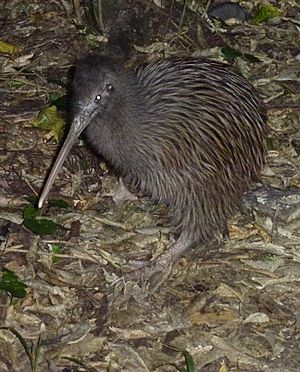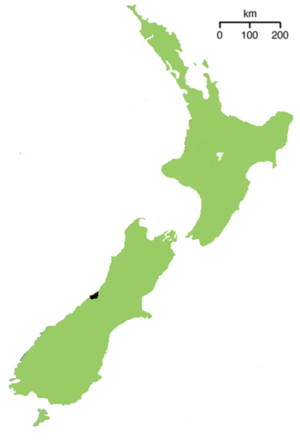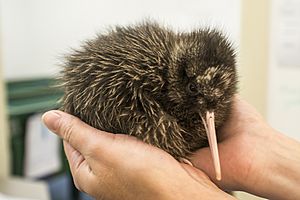Okarito kiwi facts for kids
Quick facts for kids Okarito kiwi |
|
|---|---|
 |
|
| Adult Okarito kiwi | |
| Conservation status | |
| Scientific classification | |
| Genus: |
Apteryx
|
| Species: |
rowi
|
 |
|
| Synonyms | |
|
|
The Okarito kiwi (Apteryx rowi), also called the rowi, is a special type of kiwi bird. Scientists officially described it as a new species in 2003. It looks a lot like other brown kiwi birds.
You can find the Okarito kiwi only in a small part of the Okarito forest. This forest is on the West Coast of New Zealand's South Island. There are only about 600 of these birds left. Some Okarito kiwi can live for a very long time, possibly up to 100 years!
Contents
About the Okarito Kiwi
The Okarito kiwi is a unique species, meaning it doesn't have different types or subspecies. Its scientific name, Apteryx, comes from a Greek word that means "without wings." This is because kiwi birds have tiny wings and cannot fly.
Scientists first thought the Okarito kiwi was the same as the Southern brown kiwi. But DNA tests showed they are different. The Okarito kiwi separated from the Southern brown kiwi about 8.2 million years ago. It split from its closest relatives, the North Island brown kiwi, about 6.2 million years ago.
Kiwi birds are part of a group called ratites. This group includes other large, flightless birds like emus, ostriches, rheas, and cassowarys. Like other ratites, the Okarito kiwi has a flat sternum (breastbone) without a keel. This is different from birds that fly, which have a keel for strong flight muscles. Kiwi also have very small wings and no preen gland, which helps other birds keep their feathers waterproof. Their feathers are also unique, without the tiny hooks that usually link feather parts together.
Where Okarito Kiwi Live
The Okarito kiwi lives in the Okarito forest on the West Coast of New Zealand's South Island. To help their numbers grow, three breeding pairs were moved to Blumine Island in 2010. This was part of a special program to protect them.
Okarito Kiwi Reproduction
Female Okarito kiwi can lay up to three eggs. Each egg is laid in a different nest. Both the male and female kiwi take turns sitting on the eggs to keep them warm until they hatch. This is called incubating the eggs.
Kiwi eggs are very big compared to the mother bird. An Okarito kiwi egg can weigh about 20% of the female's body weight! Most Okarito kiwi pairs stay together for their entire lives, meaning they are monogamous.
Protecting the Okarito Kiwi
The Okarito kiwi is listed as a Vulnerable species by the IUCN. This means it is at risk of disappearing forever. The main reasons for this are that their homes (habitat) are shrinking and they are hunted by animals like stoats. Stoats are small, fierce animals that were brought to New Zealand by people.
Many people are working hard to protect the rowi. Programs like "Operation Nest Egg" and efforts to control stoats have helped. These programs have slowly increased the number of rowi. However, the rowi is still in danger. Hunting by introduced animals, especially stoats, is still the biggest threat. In 2000, the South Okarito Forest was made a special kiwi sanctuary to keep them safe.
The West Coast Wildlife Centre in Franz Josef village runs a big part of "Operation Nest Egg." They carefully remove kiwi eggs that are in danger from predators. The chicks hatch safely in captivity. Then, they are raised in a natural area where there are no predators. Once the young kiwi are big enough to take care of themselves, they are released back into the wild.
This program started in 2010. It has helped the wild rowi population grow from only 165 older birds in the 1990s to about 600 birds by 2019. Studies show that the kiwi raised in this program act just like those that grew up entirely in the wild. The Wildlife Centre is also the only place in New Zealand where you can see rowi in a special area that looks like their home at night.
See also
 In Spanish: Rowi o kiwi de okarito para niños
In Spanish: Rowi o kiwi de okarito para niños



